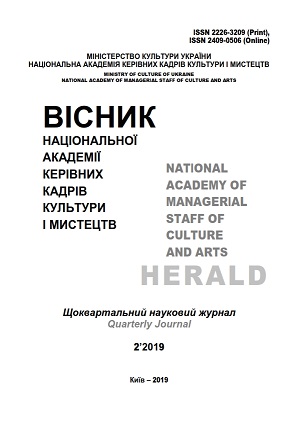Ukrainian Second-Stage Nonconformism: Features of Development
Ukrainian Second-Stage Nonconformism: Features of Development
Author(s): Oleksii Oleksiyovych RohotchenkoSubject(s): Cultural history, Higher Education , History of Education, Post-War period (1950 - 1989), Sociology of Art, History of Art
Published by: Національна академія керівних кадрів культури і мистецтв
Keywords: nonconformism; dissent; socialist realism; artist; art studies; culturology;
Summary/Abstract: Purpose of the study is to present the author’s standpoint on the issue of inner resistance in the non-liberal Ukrainian art community. The research covers the period since the 1960s through 1980s, when the author was a student at the Kyiv State Art Institute, a researcher at the Museum of Folk Architecture and Life of the Ukrainian SSR, a senior researcher at the Ukrhudozprom (Ukrainian applied arts enterprise), and a member of the Union of Artists of Ukraine. Using the previously unpublished materials (his own diary, interviews with the participants in the process, memories of artists, workers and members of the National Union of Artists of Ukraine), the author suggests an interpretation of the problem of Ukrainian nonconformism with regard not only to the artistic, but also to the sociocultural component of the phenomenon. The methodology employed in the study includes new methods of studying nonconformism, built primarily on the author’s own experience. In addition, the methods of art history studies and analysis, the structural-functional approach and the method of interviewing were used. The applied methodological approach broadened possible understanding of the long-hushed issue of artistic resistance to the official totalitarian doctrine. Scientific novelty of the results. The author intends to cover the problem basing on the impartial analysis of the studies of Ukrainian and foreign art historians and on the author’s own experience as the participant of the art process of the time. The article for the first time presents author’s personal theoretical approach to the important scientific problem, arising from a situation with no unanimous opinion and assessment of the artistic phenomenon. Conclusions. The revival of nonconformism as a cultural and artistic phenomenon meant enacting of modernist stylistics, embracing forbidden formalism and using postmodern trends within the cultural space of Soviet Ukraine. After the death of Stalin historical conditions changed, and the artistic circles reacted on temporary political “thaw” accordingly—that was a start of inevitable social changes resulting in new artistic phenomena and new artistic forms. As for the Ukrainian nonconformism, it should be noted that it never mimicred artistic life of the West of the studied period. As to the global context, it, undoubtedly, influenced the Ukrainian “phenomenon of dissent”. The methodology of the avant-garde ideas, as well as its stylistics, were revived anew in the Ukrainian nonconformism of the 1960s through 1980s. The “second revival” of nonconformism in Ukraine was the transgression of the so-called “Executed Renaissance” of the 1920s and early 1930s.
Journal: Вісник Національної академії керівних кадрів культури і мистецтв
- Issue Year: 2019
- Issue No: 2
- Page Range: 318-322
- Page Count: 5
- Language: English

